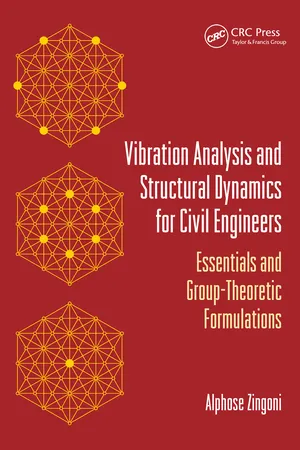
Vibration Analysis and Structural Dynamics for Civil Engineers
Essentials and Group-Theoretic Formulations
- 276 pages
- English
- ePUB (mobile friendly)
- Available on iOS & Android
Vibration Analysis and Structural Dynamics for Civil Engineers
Essentials and Group-Theoretic Formulations
About this book
Appeals to the Student and the Seasoned Professional
While the analysis of a civil-engineering structure typically seeks to quantify static effects (stresses and strains), there are some aspects that require considerations of vibration and dynamic behavior. Vibration Analysis and Structural Dynamics for Civil Engineers: Essentials and Group-Theoretic Formulations is relevant to instances that involve significant time-varying effects, including impact and sudden movement. It explains the basic theory to undergraduate and graduate students taking courses on vibration and dynamics, and also presents an original approach for the vibration analysis of symmetric systems, for both researchers and practicing engineers. Divided into two parts, it first covers the fundamentals of the vibration of engineering systems, and later addresses how symmetry affects vibration behavior.
Part I treats the modeling of discrete single and multi-degree-of-freedom systems, as well as mathematical formulations for continuous systems, both analytical and numerical. It also features some worked examples and tutorial problems. Part II introduces the mathematical concepts of group theory and symmetry groups, and applies these to the vibration of a diverse range of problems in structural mechanics. It reveals the computational benefits of the group-theoretic approach, and sheds new insights on complex vibration phenomena.
The book consists of 11 chapters with topics that include:
- The vibration of discrete systems or lumped parameter models
- The free and forced response of single degree-of-freedom systems
- The vibration of systems with multiple degrees of freedom
- The vibration of continuous systems (strings, rods and beams)
- The essentials of finite-element vibration modelling
- Symmetry considerations and an outline of group and representation theories
- Applications of group theory to the vibration of linear mechanical systems
- Applications of group theory to the vibration of structural grids and cable nets
- Group-theoretic finite-element and finite-difference formulations
Vibration Analysis and Structural Dynamics for Civil Engineers: Essentials and Group-Theoretic Formulations acquaints students with the fundamentals of vibration theory, informs experienced structural practitioners on simple and effective techniques for vibration modelling, and provides researchers with new directions for the development of computational vibration procedures.
Frequently asked questions
- Essential is ideal for learners and professionals who enjoy exploring a wide range of subjects. Access the Essential Library with 800,000+ trusted titles and best-sellers across business, personal growth, and the humanities. Includes unlimited reading time and Standard Read Aloud voice.
- Complete: Perfect for advanced learners and researchers needing full, unrestricted access. Unlock 1.4M+ books across hundreds of subjects, including academic and specialized titles. The Complete Plan also includes advanced features like Premium Read Aloud and Research Assistant.
Please note we cannot support devices running on iOS 13 and Android 7 or earlier. Learn more about using the app.
Information
Table of contents
- Cover
- Half Title
- Title Page
- Copyright Page
- Table of Contents
- List of Illustrations
- List of tables
- Preface
- Acknowledgments
- About the author
- Part I: Essentials
- Part II: Group-theoretic formulations
- Index